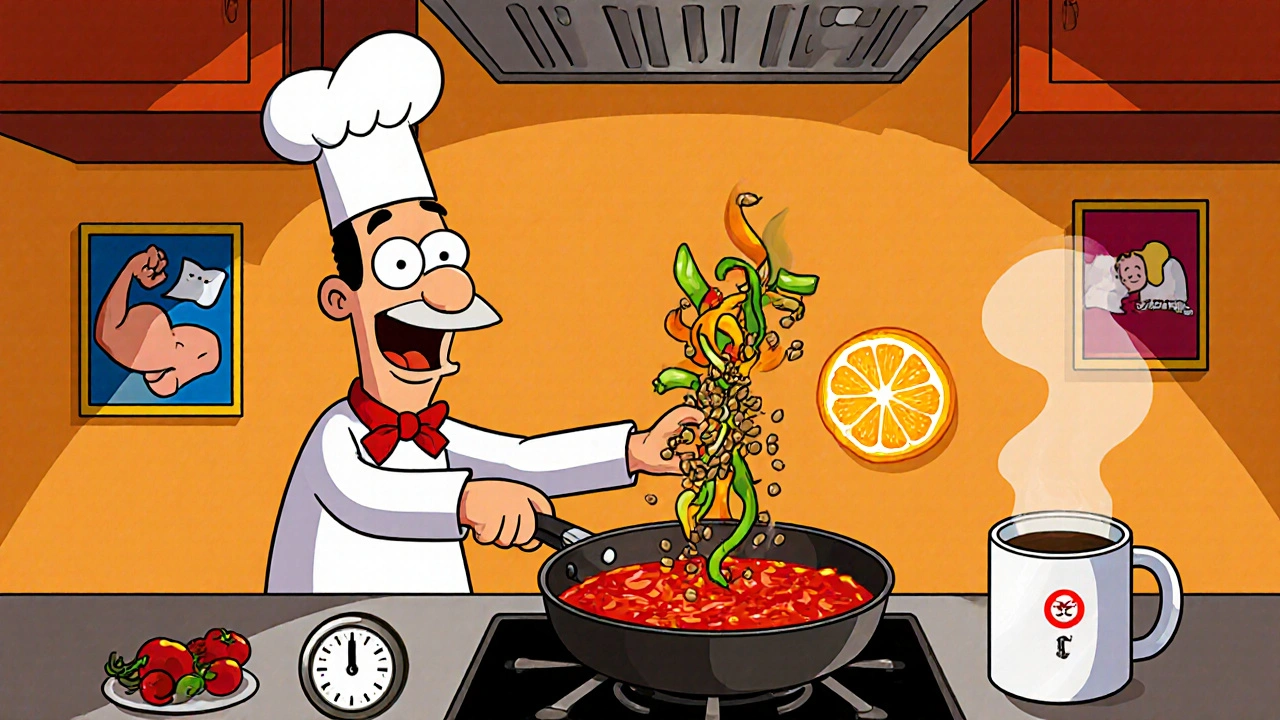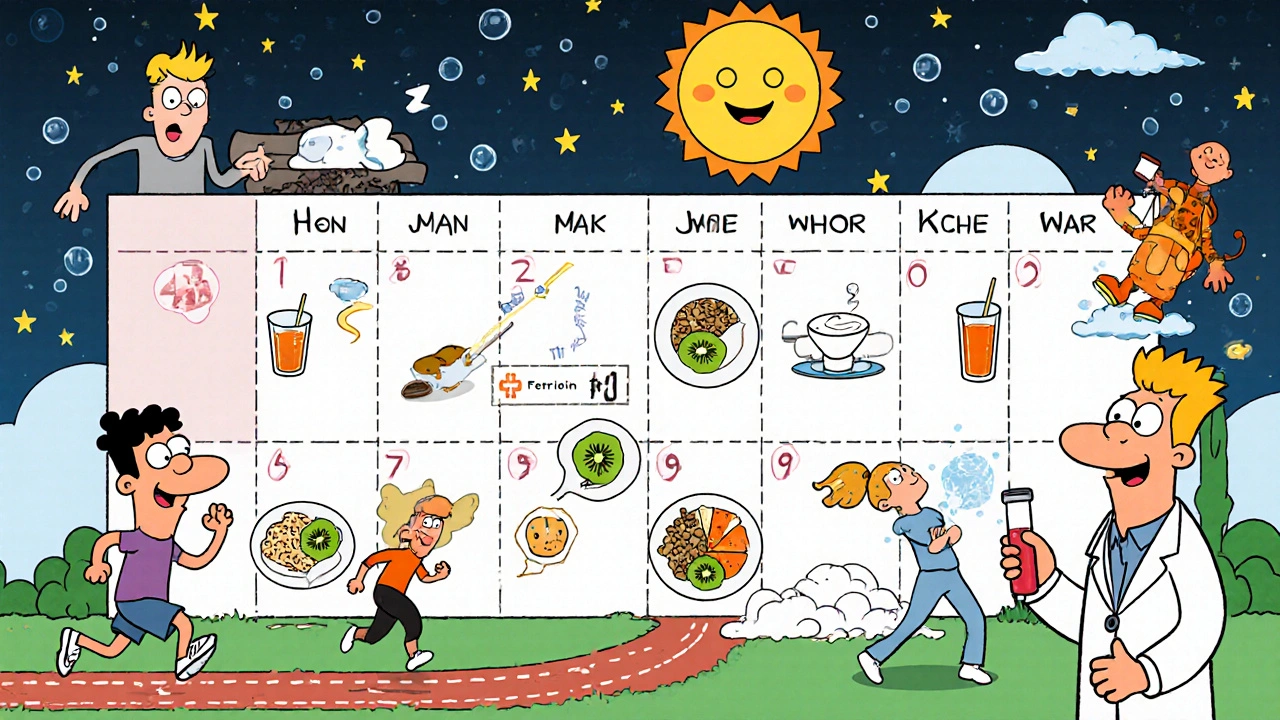Iron Intake Calculator
Your Daily Iron Intake
Select foods you've eaten today to calculate your iron intake and absorption rate.
Results
When you hear the words prevent iron deficiency anemia, you probably picture pills or a doctor’s note. In reality, most of the battle can be won at the kitchen table and in everyday habits. Below you’ll find a step‑by‑step plan that blends food choices, cooking tricks, and lifestyle tweaks to keep your iron levels healthy without relying on medication.
Key Takeaways
- Focus on heme iron from animal sources and boost its absorption with vitamin C.
- Pair plant‑based iron foods with acidic foods and avoid inhibitors like coffee during meals.
- Regular physical activity, adequate sleep, and stress management support iron metabolism.
- Women of childbearing age, pregnant people, and athletes need extra attention to iron intake.
- Simple cooking methods-soaking, sprouting, and using cast‑iron cookware-can add up to 2 mg of iron per serving.
Understanding Iron Deficiency Anemia
Iron Deficiency Anemia occurs when the body lacks enough iron to produce hemoglobin, the protein that carries oxygen in red blood cells. Without sufficient hemoglobin, fatigue, shortness of breath, and reduced cognitive function become common. The condition affects roughly 1.6 billion people worldwide, with women and children bearing the highest burden.
Iron is stored in the body as ferritin. Low ferritin levels are the earliest biochemical sign of depletion, often before anemia shows up on a complete blood count. Recognizing these early markers helps you intervene before you feel the classic fatigue.
How Iron Works in the Body
Two main forms of dietary iron exist:
- Heme iron-found in animal products like red meat, poultry, and fish. It’s absorbed at a rate of 15‑35 %.
- Non‑heme iron-present in plant foods, grains, and legumes. Absorption ranges from 2‑20 % and is heavily influenced by other nutrients.
Iron is essential for enzyme function, DNA synthesis, and immune health. Its absorption takes place mainly in the duodenum, where an acidic environment helps convert iron into a soluble form.
Dietary Pillars for Iron‑Rich Eating
Build your meals around three pillars: iron‑dense foods, absorption enhancers, and inhibitor blockers.
1. Choose Iron‑Dense Foods
Here’s a quick cheat sheet of the top iron contributors (per 100 g):
| Food | Type | Iron (mg) | Absorption Rate |
|---|---|---|---|
| Beef liver | Heme | 6.5 | 30‑35 % |
| Chicken thigh (cooked) | Heme | 1.3 | 15‑20 % |
| Lentils (cooked) | Non‑heme | 3.3 | 5‑12 % |
| Spinach (cooked) | Non‑heme | 3.6 | 5‑10 % |
| Quinoa (cooked) | Non‑heme | 2.8 | 7‑15 % |
| Pumpkin seeds | Non‑heme | 3.3 | 6‑12 % |
| Tofu (firm) | Non‑heme | 2.7 | 5‑10 % |
| Dark chocolate (70% cacao) | Non‑heme | 11.9 | 10‑15 % |
2. Boost Absorption with Vitamin C
Vitamin C turns ferric iron (Fe³⁺) into ferrous iron (Fe²⁺), the form the gut can absorb. Pair any non‑heme source with a vitamin C‑rich companion:
- Lentil soup + a squeeze of lemon
- Spinach salad with orange segments or strawberries
- Stir‑fried tofu with bell peppers and broccoli
A 50‑mg dose of vitamin C can raise non‑heme iron absorption by up to 70 %.
3. Limit Inhibitors at Meal Time
Several foods and drinks bind iron and reduce uptake:
- Calcium - dairy, fortified juices, and calcium supplements compete for the same transporters.
- Polyphenols - coffee, tea, and some red wines contain tannins that chelate iron.
- Phytates - whole grains, legumes, and nuts store iron in a bound form.
Strategy: enjoy tea or coffee at least an hour before or after iron‑rich meals, and spread calcium‑rich foods to other times of the day.

Cooking Tricks That Add Iron
Simple kitchen hacks can boost both the iron content and its bioavailability:
- Soak and sprout legumes - soaking for 8‑12 hours and allowing a 24‑hour sprouting period reduces phytates by up to 60 %. \n
- Use cast‑iron cookware - cooking acidic foods (tomato sauce, chili) in a cast‑iron pan can add 2‑5 mg of iron per serving.
- Ferment grains - sourdough fermentation lowers phytate content, improving iron absorption.
- Combine meat with veggies - adding vitamin C‑rich vegetables to meat stews creates a synergistic effect.
Lifestyle Factors That Influence Iron Balance
Even the best diet can fall short if other habits sabotage iron metabolism.
Physical Activity
Moderate aerobic exercise stimulates red blood cell production. Endurance athletes, however, may experience higher iron loss through sweat and gastrointestinal bleeding, so they often need 1.5‑2 times the average iron intake.
Sleep & Stress
Chronic stress elevates cortisol, which can suppress erythropoietin-the hormone that drives red blood cell formation. Aim for 7‑9 hours of quality sleep and practice stress‑relief techniques (mindful breathing, short walks) to keep the hormonal balance in check.
Menstrual Health
Women with heavy periods lose 1‑2 mg of iron daily. Tracking flow with a mobile app helps identify when supplemental dietary iron or a medical evaluation is needed.
Pregnancy & Lactation
During pregnancy, iron requirements jump to 27 mg per day-almost double the non‑pregnant recommendation. Including early‑trimester iron‑rich meals and continuing through the third trimester reduces the risk of preterm birth and low‑birth‑weight infants.
Putting It All Together: A Sample 7‑Day Meal Plan
Below is a realistic, budget‑friendly menu that hits the iron target (≈18 mg per day for most adults) while keeping meals tasty.
- Day 1: Breakfast - Oatmeal cooked in water with pumpkin seeds, raisins, and a squeeze of orange juice. Lunch - Spinach salad with grilled chicken, strawberries, and balsamic vinaigrette. Dinner - Beef stir‑fry with bell peppers, served over quinoa.
- Day 2: Breakfast - Greek yogurt (skip if low calcium) topped with sliced kiwi and a handful of almonds. Lunch - Lentil soup (pre‑soaked) with a side of whole‑grain toast. Dinner - Baked salmon, steamed broccoli, and sweet potato.
- Day 3: Breakfast - Smoothie with kale, banana, mango, and fortified plant‑milk (choose low‑calcium). Lunch - Chickpea salad with red bell pepper, parsley, and lemon dressing. Dinner - Turkey meatballs in tomato sauce, cooked in a cast‑iron skillet, served with brown rice.
- Day 4: Breakfast - Scrambled eggs with sautéed spinach and mushrooms. Lunch - Quinoa bowl with roasted beet, feta (moderate calcium), and orange segments. Dinner - Grilled shrimp, asparagus, and a side of couscous.
- Day 5: Breakfast - Whole‑grain toast with peanut butter and sliced strawberries. Lunch - Black‑bean burrito (beans soaked & rinsed) with salsa and avocado. Dinner - Lamb kebabs with bell peppers, served with a cucumber‑yogurt dip.
- Day 6: Breakfast - Smoothie bowl with açai, blueberries, and hemp seeds. Lunch - Tofu stir‑fry with bok choy, carrots, and a splash of lime. Dinner - Roast chicken thigh, roasted carrots, and a side of lentil mash.
- Day 7: Breakfast - Muesli with dried apricots, pumpkin seeds, and almond milk. Lunch - Turkey wrap with lettuce, tomato, and a drizzle of lemon‑olive oil. Dinner - Beef liver pâté on whole‑grain crackers, side of arugula salad with orange vinaigrette.
Adjust portions based on your calorie needs; the iron totals stay within the recommended range.

When Diet Isn’t Enough: Supplement Guidance
If you still struggle to hit the iron target after two weeks of strict diet changes, consider a supplement. Preferred options:
- Ferrous sulfate - 65 mg elemental iron per tablet; take with vitamin C and avoid coffee/tea.
- Ferrous gluconate - gentler on the stomach, 35 mg elemental iron per tablet.
- Iron bisglycinate - highly bioavailable, minimal GI upset.
Never exceed 45 mg of elemental iron per day without medical supervision, as excess iron can cause oxidative stress.
Common Pitfalls & How to Fix Them
- Relying solely on plant sources - Pair every non‑heme meal with vitamin C and use cooking tricks to lower phytates.
- Skipping meals - Iron absorption is a cumulative process; consistent intake matters more than occasional large meals.
- Drinking coffee with breakfast - Move your coffee to mid‑morning or after lunch to avoid the tannin effect.
- High‑calcium dairy at every meal - Limit to one serving per day or separate from iron‑rich foods.
Quick FAQ
How much iron do adults need daily?
Adult men need about 8 mg of elemental iron per day, while adult women (19‑50) require 18 mg due to menstrual losses. Pregnant individuals need 27 mg.
Can I get enough iron from a vegetarian diet?
Yes, but you must prioritize iron‑rich plant foods, use vitamin C boosters, and apply cooking methods that reduce phytates. Regular blood tests help track progress.
Is it safe to take iron supplements without a diagnosis?
No. Excess iron can damage organs. Always get a ferritin or hemoglobin test before starting supplements.
Why does coffee affect iron absorption?
Coffee contains tannins that bind iron, forming insoluble complexes that the gut cannot absorb.
How long does it take to recover from iron deficiency anemia?
With proper diet and, if needed, supplements, most people see hemoglobin improvements within 4‑6 weeks and full recovery in 3‑6 months.
Next Steps
1. **Audit your current meals** - Write down what you eat for three days and note iron‑rich items.
2. **Add a vitamin C pair** - For each non‑heme dish, include a citrus fruit, bell pepper, or tomato.
3. **Adjust timing** - Move tea/coffee away from iron meals and schedule calcium foods separately.
4. **Cook smarter** - Try a cast‑iron skillet for your next tomato sauce.
5. **Get tested** - Book a ferritin test; use the results to fine‑tune your plan.
By following these steps, you’ll build a sustainable routine that not only prevents iron deficiency anemia but also boosts overall energy and well‑being.


Shan Reddy
October 23, 2025 AT 18:00Thanks for putting this together; the step‑by‑step layout makes it easy to follow. I’ve started swapping my morning coffee for orange juice and it already feels less sluggish. Soaking lentils overnight has become a habit, and the reduced phytic acid really seems to help. Using a cast‑iron skillet for my tomato sauce added a subtle iron boost I didn’t expect. Pairing spinach with strawberries for lunch is a simple trick that tastes great. Overall, these small tweaks add up without feeling like a strict diet.
CASEY PERRY
October 23, 2025 AT 20:46The protocol aligns with established heme–non‑heme absorption mechanisms. Vitamin C acts as a reductant, converting Fe³⁺ to Fe²⁺, thereby enhancing transporter affinity. Phytate chelation is mitigated via germination, as demonstrated in controlled trials. adherence to temporal separation of calcium and iron sources optimizes uptake.
Naomi Shimberg
October 23, 2025 AT 23:33While the article commendably aggregates conventional wisdom, it neglects the nuanced risks associated with excessive iron intake, particularly in populations with occult hemochromatosis. The recommendation to indiscriminately employ cast‑iron cookware may inadvertently elevate serum ferritin beyond safe thresholds. Moreover, the suggestion to supplement with ferrous sulfate without routine ferritin monitoring borders on imprudent medical advice. One must consider genetic predispositions, dietary iron bioavailability variability, and the potential for oxidative stress induced by surplus iron. Thus, a more circumspect approach, emphasizing individualized assessment, would better serve readers.
Heather ehlschide
October 24, 2025 AT 02:20Indeed, personalized assessment is the cornerstone of any effective nutritional strategy, and iron metabolism exemplifies this principle. First, a baseline measurement of serum ferritin, transferrin saturation, and complete blood count provides a reliable snapshot of an individual’s iron status; without these data, any blanket recommendation risks either under‑ or over‑supplementation. Second, the bioavailability of dietary iron is heavily modulated by the presence of enhancers such as ascorbic acid and inhibitors like phytates, calcium, and polyphenols, and these interactions differ markedly between individuals due to variations in gut microbiota composition and gastric acidity. Third, for athletes or those engaged in high‑intensity training, the increased turnover of red blood cells and sweat losses can raise iron requirements substantially, sometimes necessitating up to twice the Recommended Dietary Allowance, yet this must be calibrated against possible gastrointestinal side effects from oral iron salts. Fourth, women of reproductive age, especially those experiencing menorrhagia, should be counseled on both dietary sources and the timing of iron‑rich meals relative to menstrual cycles to mitigate episodic deficits. Fifth, pregnant individuals experience a physiological surge in plasma volume and fetal iron demands; thus, early prenatal screening and targeted dietary modifications, such as incorporating lean red meat and fortified grains, become critical. Sixth, the role of cast‑iron cookware, while beneficial in adding modest amounts of elemental iron, should be contextualized; the actual transfer depends on cooking duration, acidity of the food, and the condition of the pan’s seasoning, and excessive reliance on this method may give a false sense of security. Seventh, the choice of supplement formulation-ferrous sulfate versus ferrous gluconate versus iron bisglycinate-should be guided by tolerability, absorption efficiency, and the patient’s gastrointestinal sensitivity, with bisglycinate often offering superior bioavailability with fewer side effects. Eighth, clinicians must remain vigilant for signs of iron overload, such as elevated serum ferritin in the absence of inflammation, as chronic excess can catalyze free radical formation and contribute to hepatic, cardiac, and endocrine pathology. Ninth, regular follow‑up intervals, typically every three to six months when initiating therapy, allow for dose adjustments and monitoring of both efficacy and safety parameters. Finally, education on meal timing-avoiding coffee, tea, or high‑calcium foods within an hour of iron‑rich meals-empowers individuals to maximize absorption without resorting to pharmacologic interventions. By integrating these considerations into a holistic plan, patients can achieve sustainable iron balance while minimizing the risk of adverse outcomes.
Kajal Gupta
October 24, 2025 AT 05:06Hey folks, I just wanted to add a splash of color to this discussion – think of iron as the superhero cape for your blood cells, swooping in to deliver oxygen like a boss. If you’re looking for a tasty twist, try tossing some pumpkin seeds into your morning oatmeal and drizzle a bit of lemon juice over it; the zest works like a secret sidekick for iron absorption. And don’t forget the power of a good old‑fashioned beetroot salad – it’s earthy, vibrant, and packs a punch of non‑heme iron that pairs beautifully with a handful of citrus segments. For those who love a bit of drama in the kitchen, simmering a tomato‑rich stew in a cast‑iron pot not only adds flavor but also subtly inks extra iron onto your plate. Keep it simple, keep it tasty, and your blood will thank you.
Zachary Blackwell
October 24, 2025 AT 07:53Yo, the “simple” iron hacks sound legit until you realize big pharma’s agenda hides behind those “natural” tips, making us think we’re safe while they push synthetic supplements that keep them in power. Cast‑iron pans? Sure, but the iron they add is barely absorbed when you’re sipping your overpriced kombucha anyway, because the industry’s fluoride‑rich water sabotages gut absorption. And those vitamin C boosters? Just a marketing ploy to sell more oranges – the real fix is to ditch the fortified foods and start growing your own bio‑engineered super‑greens that the mainstream media can’t touch. Wake up, question the narrative, and don’t let the “expert” advice keep you chained.
Michaela Dixon
October 24, 2025 AT 10:40I've been diving deep into the literature on iron bioavailability and must say that the interplay between dietary components is astonishingly intricate, especially when you consider that phytates, which are abundant in whole grains and legumes, can sequester iron in a manner that renders it almost invisible to the intestinal mucosa, thereby dramatically reducing absorption rates, and yet simple culinary techniques such as soaking, sprouting, or fermenting can dramatically alter that dynamic by enzymatically degrading phytate structures, releasing the trapped mineral for uptake, which is why I always recommend a multi‑day soaking protocol for beans coupled with a short fermentation period for grains, and then follow that with a citrus‑rich garnish to further convert ferric ions to the more readily absorbed ferrous form, all while ensuring that calcium‑rich foods are strategically spaced out, because calcium competes for the DMT1 transporter, creating a subtle but significant antagonistic effect that can blunt the benefits of even the most iron‑dense meals, and let’s not overlook the role of gut microbiota, which can modify iron homeostasis via bacterial siderophores, adding another layer of complexity that researchers are just beginning to untangle.
Dan Danuts
October 24, 2025 AT 13:26Great tips, thanks!
keerthi yeligay
October 24, 2025 AT 16:13Try add a little lemon to your iron meals it help alot.